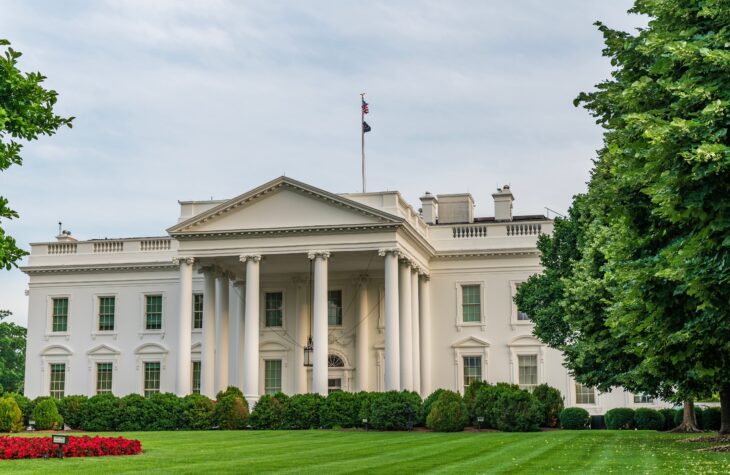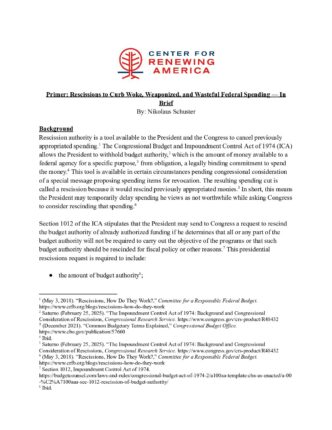
Primer: Rescissions to Curb Woke, Weaponized, and Wasteful Federal Spending — In Brief
Background
Rescission authority is a tool available to the President and the Congress to cancel previously appropriated spending.1 The Congressional Budget and Impoundment Control Act of 1974 (ICA) allows the President to withhold budget authority,2 which is the amount of money available to a federal agency for a specific purpose,3 from obligation, a legally binding commitment to spend the money.4 This tool is available in certain circumstances pending congressional consideration of a special message proposing spending items for revocation. The resulting spending cut is called a rescission because it would rescind previously appropriated monies.5 In short, this means the President may temporarily delay spending he views as not worthwhile while asking Congress to consider rescinding that spending.6
Section 1012 of the ICA stipulates that the President may send to Congress a request to rescind the budget authority of already authorized funding if he determines that all or any part of the budget authority will not be required to carry out the objective of the programs or that such budget authority should be rescinded for fiscal policy or other reasons.7 This presidential rescissions request is required to include:
- the amount of budget authority8;
- the account or department for which the budget authority was provided and any specific project or governmental functions involved9;
- the reasons why the budget authority should be rescinded10;
- any estimated fiscal, economic, or budgetary effect11; and
- any additional facts, circumstances, or considerations relating to the proposed rescission.12
If Congress does not rescind all or part of the amount requested or if it fails to act at all, which is also its prerogative, the funds that were withheld become available after a prescribed 45-day period.13 As is likely apparent, the contours of the ICA’s rescission authority shift nearly all the leverage to Congress as it pertains to previously understood presidential impoundment powers. This unconstitutional dynamic severely limits the President’s ability to ensure the faithful execution of the law while simultaneously transforming appropriations into both a spending ceiling and spending floor.14
Nevertheless, the rescission process is currently embedded in statute. While flawed, it is an available tool that should be considered when seeking to curb the power of the administrative state.
Consideration of Rescissions by Congress
The main feature of the rescission process outlined in the ICA is its fast-tracked and privileged consideration by Congress. It enables Congress to bypass its normal procedures to ultimately speed up consideration of rescissions proposed by the President before the expiration of the 45-day review period. According to the Congressional Research Service, once placed on the Calendar in the House of Representatives, a rescissions measure is privileged for consideration, meaning that it would take priority over all other business in the House and that any Member can move to call the measure up for a vote.15
In the Senate, a motion to proceed to the consideration of a rescission bill has been considered nondebatable, meaning it requires a simple majority to pass rather than the usual 60 votes required for most bills. Once the Senate agrees to proceed to the consideration of a rescission bill, then the total time for debate on the bill is further limited to 10 hours versus the usual 30 hours of debate on legislative measures.16 When considering rescissions, Congress can bypass almost all the procedural hurdles that increase the time it takes for the House and Senate to complete legislative business and the political hurdles often necessary to build a supportive cohort large enough to get a vote on a measure.
There are two specific instances of the fast-track procedures worth examining when discussing the privileged nature of a presidential rescission message.17 In 1992, President George H.W. Bush submitted to Congress a series of special messages proposing 128 rescissions, totaling almost $7.9 billion, which were then considered under the expedited procedures of the ICA.18 In 2018, during his first term, President Trump also transmitted a special message with 38 proposed rescissions, which were considered under the terms of a special rule in the House.19 However, the effort failed when the Senate voted against the package.20
Conclusion
In appointing and directing the Department of Government Efficiency (DOGE) to uncover the waste and abuse of taxpayer dollars across the whole of the federal government, the President is fulfilling his promise to expose and end the deep rot of the woke and weaponized bureaucracy. The Trump administration has worked expeditiously to bring this spending to light, and a rescissions package can put a permanent end to it. Such a measure receives expedited consideration in Congress and bypasses procedures that can otherwise bog down legislative priorities. If the President sends such a measure to Congress, it should move immediately to approve it. This would reassure the American people that Congress is as serious as the President about cutting woke and weaponized spending.
Endnotes
1. (May 3, 2018). “Rescissions, How Do They Work?,” Committee for a Responsible Federal Budget. https://www.crfb.org/blogs/rescissions-how-do-they-work
2. Saturno (February 25, 2025). “The Impoundment Control Act of 1974: Background and Congressional Consideration of Rescissions, Congressional Research Service. https://www.congress.gov/crs-product/R48432
3. (December 2021). “Common Budgetary Terms Explained,” Congressional Budget Office. https://www.cbo.gov/publication/57660
4. Ibid.
5. Saturno (February 25, 2025). “The Impoundment Control Act of 1974: Background and Congressional Consideration of Rescissions, Congressional Research Service. https://www.congress.gov/crs-product/R48432
6. (May 3, 2018). “Rescissions, How Do They Work?,” Committee for a Responsible Federal Budget. https://www.crfb.org/blogs/rescissions-how-do-they-work
7. Section 1012, Impoundment Control Act of 1974. https://budgetcounsel.com/laws-and-rules/congressional-budget-act-of-1974-2/a100aa-template-cba-as-enacted/a-00-%C2%A7100aaa-sec-1012-rescission-of-budget-authority/
8. Ibid.
9. Ibid.
10. Ibid.
11. Ibid.
12. Ibid.
13. Saturno (February 25, 2025). “The Impoundment Control Act of 1974: Background and Congressional Consideration of Rescissions, Congressional Research Service. https://www.congress.gov/crs-product/R48432
14. Paoletta, Mark. (Sept. 10, 2024). “The President’s Constitutional Power of Impoundment.” CRA. https://americarenewing.com/the-presidents-constitutional-power-of-impoundment/
15. Ibid.
16. Ibid.
17. Ibid.
18. Ibid.
19. Ibid.
20. Barrett (June 20, 2018). “Senate rejects spending cuts package, a White House priority, CNN. https://www.cnn.com/2018/06/20/politics/senate-vote-rescissions-package/index.html





